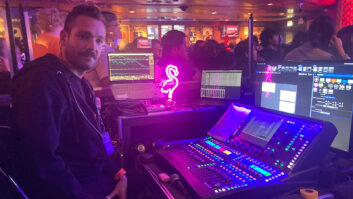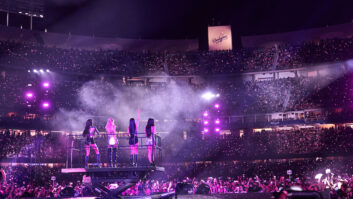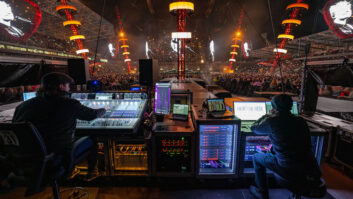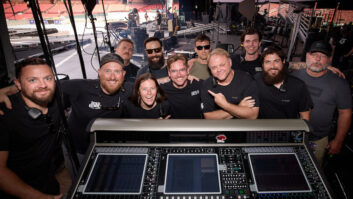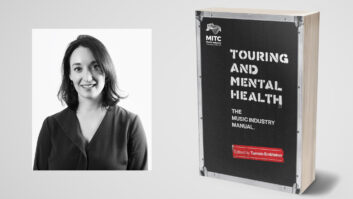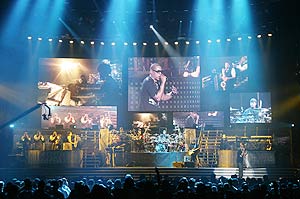

Deemed to be one of the biggest R&B/hip-hop shows on the touring spring lineup (its only true competition in this genre is the Kanye West/Rihanna double-header), the Mary J. Blige/Jay-Z extravaganza has been dazzling fans across the country with its impressive lighting show, which is only surpassed by the tour’s commitment to a high-quality audio experience. And this is no easy feat for the audio crew, as Blige (dubbed the “Queen of Hip-Hop Soul”) and Jay-Z have racked up a total of 15 Grammys to their names (eight for Blige, seven for Jay-Z), so their fans are just a bit familiar with their repertoire! Add to that a rather sizeable touring band (each artist has their own backing band), which keeps front-of-house engineers Kyle Hamilton (Blige) and Bryon “Hot Dog” Tate (Jay-Z, also production manager) on their toes.
Both engineers are mixing the two-and-a-half-hour show through twin Digidesign VENUE systems, working side-by-side on identical D-Show mixing boards interfacing with Pro Tools Version 7.3.1 and an additional D-Show as a sidecar. “We wanted a seamless transition without any set-change time,” says Tate. “Both consoles are on all the time: mix-out to sub-ins. They’re patched the same and we line up channels the way we want in our consoles, so everything that Kyle sees during Mary’s mix, I see in my console, and vice versa. All we do is mute and unmute.”
Less than 30 seconds pass between the time that Blige finishes her set and Jay-Z begins his. This is possible thanks to dual digital desks, as well as a shared miking scheme. Blige performs with a 20-piece backing ensemble that includes a drummer, percussionist, keyboard player, guitarist, bassist, an eight-piece string section, a four-piece horn section and three backup singers. As expected, Hamilton has his VENUE maxed out: “We’re stretching that console to the fullest!” he enthuses. “I receive about 80 hard channels, but we run up to 95 channels with all the ears, so we’re pushing it. But it’s fun to be able to mix a complete band and mini-orchestra section onstage. That’s unusual in the R&B and hip-hop world.”
To mix this large band, Hamilton uses minimal signal processing, save for occasional software-based comps and gates. He uses a few samples and loops during Blige’s set, but brings them in sparingly. “We run a few channels of Pro Tools, mostly loops, just to make it sound thicker on the percussion side,” Hamilton explains. “Almost everything else is just for color. And if we didn’t use them, you wouldn’t know it because the band is so incredible.”
Photos: Steve Jennings
He applies the same less-is-more philosophy to Blige’s vocals. “I use a nice tube compressor plug-in on her voice, but she sings so powerfully I have to find ways to cut gain,” he continues. “She’s an extremely strong singer. Making her sound good is almost easy because of the mic [handheld Shure KSM9] and what she gives you. She has great mic technique, too: She’s dead-center and does not cup the mic at all.”
Drums, which comprise 24 inputs on the respective VENUE consoles, are miked with Audio-Technica AE3000s for the toms, Shure KSM 32s on overheads, KSM 37s on the hi-hat, a Sennheiser 602 and Sennheiser e901 on the kick, Shure Beta 57s on the snares and another 602 on the gong. Percussion takes AKG C-414s for overheads and Audio-Technica AE3000s on congas and bongos. DPA pickups are used on the violas, violins and cellos, while an assortment of AKGs mike the horns.
Unlike Blige, who aims for a full, rich sound that’s easy on the ears, Jay-Z wants his set to feel like a full-on rock band. “It’s hip-hop, but he wants that rock feel in there,” says Tate. “He wants it in your face. So I try to create a more powerful mix.” Delivering the rapper’s horn- and bass-heavy set is a Clair Showco i4 arena P.A.: 12 i4Bs for the main hang and eight i4s per side with six i4Bs per side used for side-fill, as well as 20 Clair Showco BT218 “Bowtie” subs. QSC amps power the i4 low end, and Crown amps power the mids and highs. Sub power comes from a Powersoft K10. The Bowtie subs are a new addition to this tour, and they’ve received a positive response so far. “I think a lot of their clients are going to be impressed with them,” says Tate. “They’re very musical subs,” adds Hamilton. “They push a lot of air. It’s a nice, tight sound.”
THE HEART OF MONITOR WORLD
Monitor engineer Brian Evans has his hands full managing both acts on two Digidesign D-Show Profile mixing consoles, using every output. “Originally, the show was two artists, one band, all ears,” he says. “Now, we have two separate bands: one mostly in-ears, another mostly on wedges.”
Blige’s band relies on Sennheiser G2 wireless systems, Shure PSM 600 hardwired personal monitor systems, and a combination of Ultimate Ears, Sensaphonics and Future Sonics ear molds. When Jay-Z hits the stage, so do the Prism SRM wedges, which are used by everyone except for the background singers, the horn players and Blige’s keyboard player — all of whom remain on ears.
To further complicate matters, the two acts prefer two different volumes, but share musicians and participate in each other’s sets. “Mary’s show is very quiet and under control onstage,” Evans relates. “She’s very sensitive about that. So when Jay-Z comes down for her set, I keep the wedges kind of low. But for Jay’s set, they’re on full-throttle.”
There’s also a difference in monitor mix. “Mary likes it really bright,” Evans continues. “She’s more complicated to mix. She’s a very dynamic singer — she goes from quiet to very, very, very strong, blow-out-the-capsule-of-the-microphone full. And she doesn’t like to hear compression, so you can’t affect her input at the console. She’s very aware of her voice and she can hear when gear interferes with it. You have to be invisible, but not. You can never complain about having enough input! Jay-Z, on the other hand, doesn’t ask for much. His monitor mix is just like a big loud rock band — everything up and loud.”
To deliver these requests, Evans uses four Prism subs onstage and two Showco L3s per side for sidefill. Three Prism Blue full-range P.A. cabinets per side are flown for downfill. A total of 24 Showco SRM wedges are scattered around the stage, with 12 downstage for Jay-Z. An additional i4B serves as a drum sub.
With no real intermission between the two acts, Evans faces a long night, every night. “There are a lot of musicians to watch, and from my position I really can’t see much,” he says. “We have a really good crew. [Monitor systems engineer] Michael Dunwoody is my second set of eyes and ears. It’s a long show with a long soundcheck, and it’s loud. My ears hurt after every show.”
For the benefit of Evans’ ears and numerous other factors, Blige and Jay-Z only perform two, sometimes three, nights in a row before taking at least one day off. And for the benefit of everyone, the 150-person crew aims to keep the tour running like clockwork.
“You’d think there would be more clashing of personalities,” says Hamilton. “There’s three different camps, including opening act Dream, and every one of them is multi-Platinum. But at the end of the day, we come together as a big family. We all stay in our own lane.”
Heather Johnson is a Mix contributing editor.

WATCH: Must Play
Photo Gallery From the Tour



